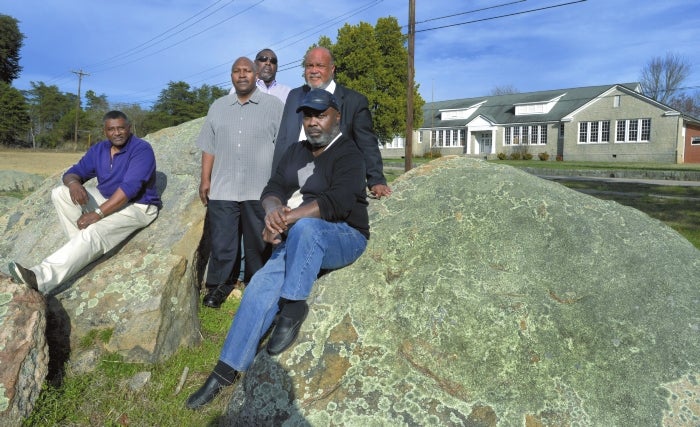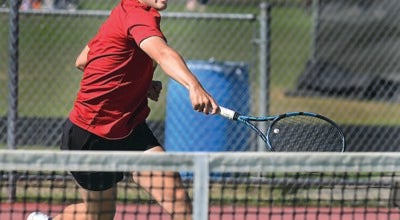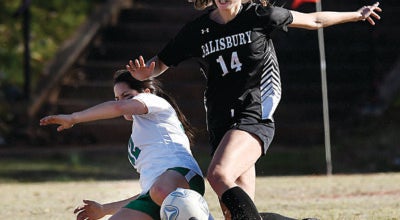Wineka column: The kids from Shuford School
Published 12:10 am Sunday, March 29, 2015

- Shuford schoolmates who went on to be part of the East Rowan championship team included Frankie Morrow, front; Jerry Sifford, Gene Davis, and Clarence Shuford, second row; and, in back, Walt Sifford. Photo by Wayne Hinshaw, for the Salisbury Post
GRANITE QUARRY — When they reminisced about Shuford Memorial School — called Granite Quarry Colored School earlier in its history — the men gathered here remembered the normal things.
Teachers. Recess. The discipline meted out.
But in looking back, the guys also recognized what the school constructed from granite meant in building their youthful self assurance and fortitude.
“It really laid the foundation for what we faced ahead,” Gene Davis said.
What lay ahead was full-blown integration. Before it took hold totally, kids from Shuford such as Jerry Sifford, Robert Steele, Theodore “June” Sifford, Willie Lowe, Clarence Shuford Jr., Frankie Morrow, Kenneth Sifford and Davis would take different paths, but they all ended up at East Rowan High School.
There, they would be part of championship football teams, and the core group would play one magical season still talked about some 45 years later.
It probably would be a stretch to make this a “Remember the Titans” type of story, but it’s tempting.
All the elements are there — an integration of talent that made a good team better, bonds developed between white and black players and a lifelong friendship forged between a white head coach and a black assistant coach.
The former Shuford School kids helped the East Rowan High football team put together an improbable, but perfect 13-0 season, ending with the Mustangs winning the Western N.C. High School Athletic Activities title in 1969 — a time when that was pretty much the equivalent of a state championship.
“It was a team,” said Shuford, a junior offensive lineman on the 1969 squad, and he emphasized the word “team.”
“In order to be champions, we had to be a team. It was a good mesh, and it just worked out.”
Aaron Neely was one of the first African-American teachers at East Rowan High and an assistant football coach for that team, piloted by head coach W.A. Cline.
“W.A. was always visionary, you know,” Neely said. “At that time, there were a lot of head coaches who found ways not to play black athletes. W.A. was not like that.”
•••
On a recent spring day, Shuford, Davis, Frankie Morrow and Jerry Sifford gathered under a shelter outside the Geneva Oglesby Recreation Center, named for one of their teachers at Shuford Memorial.
Battling some health problems, Willie Lowe could not make it, and Robert Steele had another commitment. June Sifford now lives in Delaware, and Ken Sifford resides in Richmond, Va.
For leading the way in sports during the early days of integration, these eight men will receive “trailblazer” awards next Saturday during the biennial Shuford Memorial School reunion.
Jerry and June Sifford, Lowe, Shuford, Steele and Morrow played on the 1969 team. Davis and Ken Sifford also would be football standouts for East Rowan in the next two seasons to come.
The Oglesby Recreation Center stands just across Dunn’s Mountain Road from the 1934 school building, which in the recent past has been used mostly as a church and food bank.
The school actually was named for Clarence Shuford Jr.’s father, who died of a heart attack in 1965 when he was principal and his son was a young student. That’s when the name changed from Granite Quarry Colored School to Shuford.
Clarence Jr. is an AME Zion pastor today.
As the men sit around a picnic table and talk, they recite the names of each teacher at Shuford: Eva Johnson, Helen Woods, Pauline Morton, Rosebud Aggrey, Geneva Oglesby, Bessie Craige, Daniel Partee and John Reddick — eight teachers for eight grades.
Shuford said students at the school benefited greatly from the stability in the faculty and how each teacher was a bridge into the next grade.
“Some of those teachers — they even taught our parents,” Morrow said.
The men talked about the etiquette lessons they learned in the fourth grade, and how you had better buckle down on the books in fifth grade. They played a lot of recess games on the school’s front lawn, and there also was a Maypole in back.
The students’ textbooks were hand-me-downs from white schools. The books carried the names of several students on the inside covers, and pages often were written on, torn or missing completely.
Bible study and prayer often were integrated into the students’ studies. There were morning devotionals and hymns to learn. Aggrey sometimes liked to make breakfast for her students — butter biscuits and oatmeal with raisins.
School lunches were 20 cents. Craige usually played the piano for assemblies in the school auditorium. Some alumni remember a bar of soap was kept by a water fountain in the hall in case a student’s mouth had to be washed out for spewing foul language.
Heat from a coal-fired furnace circulated through the classroom radiators and kept everything toasty in the winter.
The school regularly held fall festivals, and it was a community gathering spot.
•••
Thinking back, the men say they never played organized youth football during their days at Shuford. There were no uniforms, pads or manicured fields. Football and basketball games were of the pick-up variety.
Shuford and Morrow were members of the last eighth-grade class at Shuford School and the first ninth-grade class at a newly built Erwin Junior High. Davis and Sifford entered the first eighth-grade class at Erwin.
More than uneasiness about race, just going to a new school and not knowing what to expect was tough, Shuford said of attending Erwin and then East Rowan High a year after that.
Shuford and Morrow joined the Erwin football team, which went undefeated, and it was the first time the former Shuford School students had worn football uniforms.
Meanwhile, Lowe, Steele, Jerry and June Sifford were attending Dunbar High School in East Spencer for two years and playing football there. But when the buses no longer would transport them to the all-black school and its closing was imminent, Jerry Sifford said, they enrolled at East Rowan High.
At East Rowan High, the men said the white-to-black ratio among students seemed to be 9 to 1. “A lot of times,” Morrow said, “we were the only one (black student) in class.”
They found a way to fit in through football and track.
“When they came in,” Neely said of the talented black players, “we had to go through some adjustments. Some of the guys had never played with black athletes.”
•••
The African-American players appreciated Cline’s approach. They say he was a strict disciplinarian, but he treated everyone the same. One thing Shuford said he will always remember is that Cline took the whole team — black and white — to his church, and they also had a celebratory dinner once at the Country Club of Salisbury.
Neely said to Cline’s credit he showed no preferential treatment toward any players, nor was he unnecessarily derogatory.
“He just wanted the best people to play,” Neely said, “and that’s the reason East was successful. We had some good athletes, white and black, but what really made the team was putting them in the right places.”
If there was any resentment from the white players toward the infusion of black players into the lineup, it didn’t last long, Neely said. By the time two-a-day summer practices were over and the seasons were starting, “there was no question those kids had abilities they hadn’t seen before,” Neely added.
Neely recalled when Jerry Sifford first came to East Rowan High, and the Mustangs had a white linebacker who thought he was All-American caliber. In practice Sifford broke away for healthy runs three times, and each time he eventually hit the linebacker head on and spun him around.
“I bet it was almost like tackling a rock,” Neely said of the collisions. “It woke him up. Sifford was just like a stone.”
East Rowan had good white players, led by the tandem of quarterback C.M. Yates and wide receiver Johnny Yarbrough. They set passing and receiving records for East Rowan that weren’t broken until this past season.
In the 1969 championship season, Yates and Yarbrough, the “Y boys,” combined for 18 touchdowns and 1,169 yards. Steele and Shuford were offensive linemen for them, and Sifford was a featured running back.
But the defense might have been just as important that season, and Morrow described Lowe as its heart and soul.
“I think the team belonged to Willie Lowe,” Morrow said.
•••
Lowe would be named the North Piedmont Conference Defensive Player of the Year. Neely said Lowe was quick enough to be part of the 400-meter relay on the track team, and the football team’s 4-3 defense was all about getting to a spot quickly.
Lowe probably weighed about 200 pounds and was all muscle. Neely said he was a vicious competitor who showed no pity for his opponents.
He would constantly talk to players across the line from him.
“Other teams hated him,” Neely said, “because he would tell you, ‘I’m coming. I’m coming through that hole right there,’ and they couldn’t stop him.”
East Rowan High School had been integrated several years before this group of guys came along, but African-American faces in the student body were still a rarity in 1969, ’70 and ’71.
In the yearbook photograph of the 1969 edition of the East Rowan Mustangs, there are 44 football players and coaches pictured. Of those faces, only six are African-American — players Jerry Sifford, Steele, Morrow, June Sifford and Shuford and assistant coach Neely. Lowe happened to be absent the day the photograph was taken.
Davis and Ken Sifford were playing junior varsity that year.
That 1969 team fashioned a 10-0 regular season campaign, followed by playoff wins against North Rowan, Concord and Shelby to win the WNCHSAA title.
If there were any racial tensions on the East Rowan teams, Shuford said, it’s not something any of the players dwelled on.
“The winning made it different,” Shuford said.
“Everybody likes a champion,” Davis added.
•••
Neely said the coaching staff didn’t learn until after the 1969 season was over that some of the players, black and white, were getting together on Saturdays and playing more football.
The guys from Shuford School were some of the best kids he ever coached, said Neely, who left East Rowan after 1972 and spent the next 18 years coaching and teaching at Salisbury High. Neely would coach state championship track teams at Salisbury.
When those players did something exceptional on the field, Neely said, they didn’t brag about it. They walked back to the huddle for the next play.
“They just showed you,” he said.
Some of these Shuford School alumni who became football players at East Rowan would go on to play in college, even if it was a brief stay. Lowe, for example, received a scholarship to play at Bethune Cookman, but homesickness brought him back to Granite Quarry.
Shuford tried to play at N.C. Central. “I walked on, and I walked off,” he said. “I was a big guy at East Rowan, and a little guy there.”
Davis works for an insurance company today. Jerry Sifford is employed at Freightliner. June Sifford became a dietician at Delaware State, Ken Sifford works for the IRS. Morrow is retired from a 30-year career with Alcoa. Steele, a member of the Rowan County Sports Hall of Fame, is a noted teacher and track coach.
Cline and Neely also were inducted into the Rowan County Sports Hall of Fame.
The 1968, 1969 and 1970 East Rowan teams all won North Piedmont Conference football titles. The Mustangs’ record over those three years was 31-4-1.
Players whose education started at a small rock school on Dunn’s Mountain Road had something to do with that success.
“They weren’t bad kids to coach,” Neely said.
Contact Mark Wineka at 704-797-4263, or mark.wineka@salisburypost.com.





